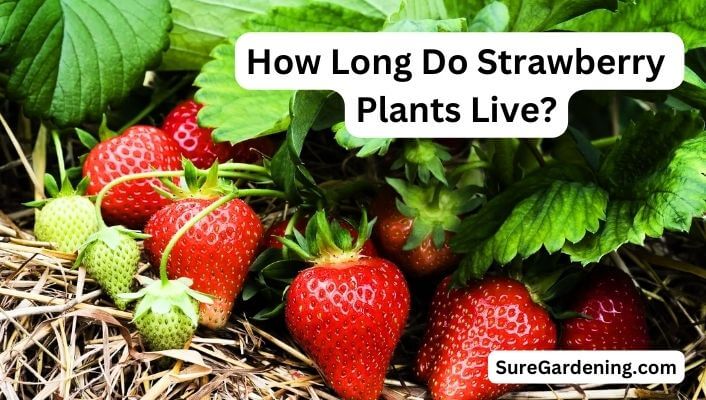Gardening enthusiasts and strawberry lovers alike often wonder, “How long do strawberry plants live?” Understanding the lifespan of these delicious berry-bearing plants is crucial for anyone looking to cultivate them.
To find out the correct answer, please continue reading.
Also, to help you extend the lifespan of strawberry plants, we’ve provided a comprehensive guide to the factors influencing strawberry plant longevity.
Having said that, let’s get started!
Post Contents
- How Long Do Strawberry Plants Live? (Answered)
- Factors Affecting Strawberry Plant Lifespan
- Pro Tips for Extending Strawberry Plant Lifespan
- How Long Do Strawberry Plants Last in Pots?
- The Right Time to Replace Your Strawberry Plant
- The Lifespan of Wild vs. Cultivated Strawberries
- FAQs about Strawberry Growth:
- 1. How can I protect my strawberry plants from pests and diseases?
- 2. Can I grow strawberries in pots or containers?
- 3. Do strawberry plants require winter protection?
- 4. Are there any companion plants that can help my strawberry plants live longer?
- 5. Should I prune my strawberry plants in the winter or spring?
- 6. Can I extend the lifespan of my strawberry plants by using organic fertilizers?
- Conclusion
- Author
How Long Do Strawberry Plants Live? (Answered)
Indeed, strawberry plants are nature’s gift that keeps on giving. The plants are perennials, so you will have juicy red treasures in your garden every year. On average, these resilient plants bless us with their presence for around six fruitful years.
But here’s the twist: After the initial two years of berry abundance, you might notice a decline in the berry bounty. It’s like they’re saying, “We’ve given you our best, now we’ll take it a bit easier.”
So, whether you’re a strawberry lover or a green-thumbed gardener, these charming perennials are here to stay and delight you with their sweet, sun-kissed offerings.
Note: You might be interested in learning more about strawberries and the different stages of their growth. We have explained each stage of growth and shared tips for effective cultivation.
Factors Affecting Strawberry Plant Lifespan
1. Environmental Factors
Strawberry plants are sensitive beings, and their lifespan can be greatly affected by the environment in which they grow. Climate, soil quality, and exposure to sunlight all play pivotal roles.
- Climate: Cold winters and hot, humid summers can take a toll on your strawberry plants. Understanding your local climate is crucial for extending your lifespan.
- Soil Quality: Strawberry plants thrive in well-drained, slightly acidic soil. Ensuring your soil meets these criteria can significantly impact its longevity.
- Sunlight: Full sun exposure is ideal for strawberry plants. Inadequate sunlight can result in weaker plants with shorter lifespans.
2. Proper Care and Maintenance
Like any living thing, strawberry plants require proper care and maintenance to thrive. Neglect can shorten their lifespan, while attentive care can help them flourish.
- Watering: Regular and consistent watering is essential. Drought or overwatering can stress the plants and affect their lifespan.
- Mulching: Applying mulch helps maintain soil moisture, regulates temperature, and reduces weed competition—all factors that contribute to longer-lasting strawberry plants.
- Spacing: Planting strawberry plants at the appropriate distance from each other promotes good air circulation, reducing the risk of diseases that can cut their lifespan short.
- Pest and Disease Management: Vigilance in protecting your plants from pests and diseases can significantly impact their lifespan. Implementing organic or chemical-free pest control measures is often recommended.
Pro Tips for Extending Strawberry Plant Lifespan
Now that we’ve discussed the factors that affect strawberry plant lifespan let’s explore some pro tips to help you maximize the longevity of your strawberry garden.
1. Strategies for Growing Healthy Strawberry Plants
Selecting disease-resistant varieties can significantly impact the lifespan of your strawberry plants. Varieties such as ‘Ozark Beauty’ and ‘Allstar’ are known for their durability.
Moreover, implementing crop rotation and adequately preparing the soil can promote healthier plants.
2. The Role of Pruning and Propagation
Pruning older strawberry plants can rejuvenate them, extending their lifespan. Removing old leaves and runners encourages the plant to focus its energy on producing new, robust growth.
Additionally, propagating your strawberry plants through runners is an excellent way to ensure a continuous supply of healthy plants.
3. Select Disease-Resistant Varieties
Certain strawberry varieties are known for their resistance to common diseases. Varieties like ‘Ozark Beauty’ and ‘Allstar’ can extend the lifespan of your strawberry plants by reducing the risk of infections.
4. Crop Rotation and Soil Preparation
Implementing crop rotation and adequately preparing the soil before planting can ensure a healthier growing environment. Disease organisms can build up in the soil over time, so changing the planting location can extend plant life.
How Long Do Strawberry Plants Last in Pots?
Curious about how long those charming potted strawberry plants will stick around? Well, in the cozy confines of a pot, these berry buddies typically put on a delightful show for about three years.
As time passes, you might notice a slight drop in berry production and overall vitality.
But hey, here’s the exciting part: When your potted strawberries decide it’s time for a change, you can work a bit of magic. Snip those runners – those adventurous little shoots that stretch out from the mother plant – and give them some space in the same pot or new ones. It’s like growing strawberry plants from scratch, and it won’t cost you a dime.
While potted strawberry plants don’t have the same longevity as those planted in the ground, they can still ripen. Keep those pots full of berry-filled life, and you’ll enjoy sweet, homegrown success for years to come.
The Right Time to Replace Your Strawberry Plant
Timing is everything when it comes to strawberry plants. If you’re aiming for plump, juicy berries year after year, knowing when to replace them is crucial. You see, these delightful perennials have their peak performance years. After they’ve dominated your garden for about 3 to 4 years, it’s time to consider a change.
Why, you ask? Well, like a tireless athlete, strawberry plants give their best in their youth. As they age, they become less productive, offering fewer and smaller berries. So, to keep the strawberry party alive and thriving, it’s a good practice to introduce fresh plants into your patch every 3 to 4 years.
Whenever you grow strawberries in pots, remember that they tend to bow out gracefully after about 3 years, meaning they won’t live to be 100 years old.
If you want to ensure your strawberry patch remains a berry paradise, schedule a timely plant refresh every few years.
The Lifespan of Wild vs. Cultivated Strawberries
Comparing the lifespan of wild strawberry plants to cultivated varieties is an interesting aspect of strawberry cultivation.
While wild strawberries may have shorter lifespans, they often produce smaller, more flavorful berries. Cultivated varieties, on the other hand, are bred for longevity and berry size.
FAQs about Strawberry Growth:
1. How can I protect my strawberry plants from pests and diseases?
Implementing natural remedies like neem oil or introducing beneficial insects can help control pests.
2. Can I grow strawberries in pots or containers?
Yes, strawberries can thrive in containers, but ensure they have proper drainage and receive sufficient sunlight.
3. Do strawberry plants require winter protection?
Yes, covering strawberry plants with straw or mulch during winter can protect them from freezing temperatures.
4. Are there any companion plants that can help my strawberry plants live longer?
Plants like marigolds and chives can deter pests and benefit strawberries when grown together.
5. Should I prune my strawberry plants in the winter or spring?
It’s best to prune strawberry plants in late winter or early spring before new growth begins.
6. Can I extend the lifespan of my strawberry plants by using organic fertilizers?
Yes, organic fertilizers can enhance soil health and contribute to the longevity of your strawberry plants.
Conclusion
In conclusion, understanding how long strawberry plants live is essential for successful gardening.
By considering factors like environmental conditions, proper care, and the use of expert tips, you can maximize the lifespan of your strawberry plants and enjoy delicious homegrown berries for years to come.
Check out some other helpful content about Strawberries:

